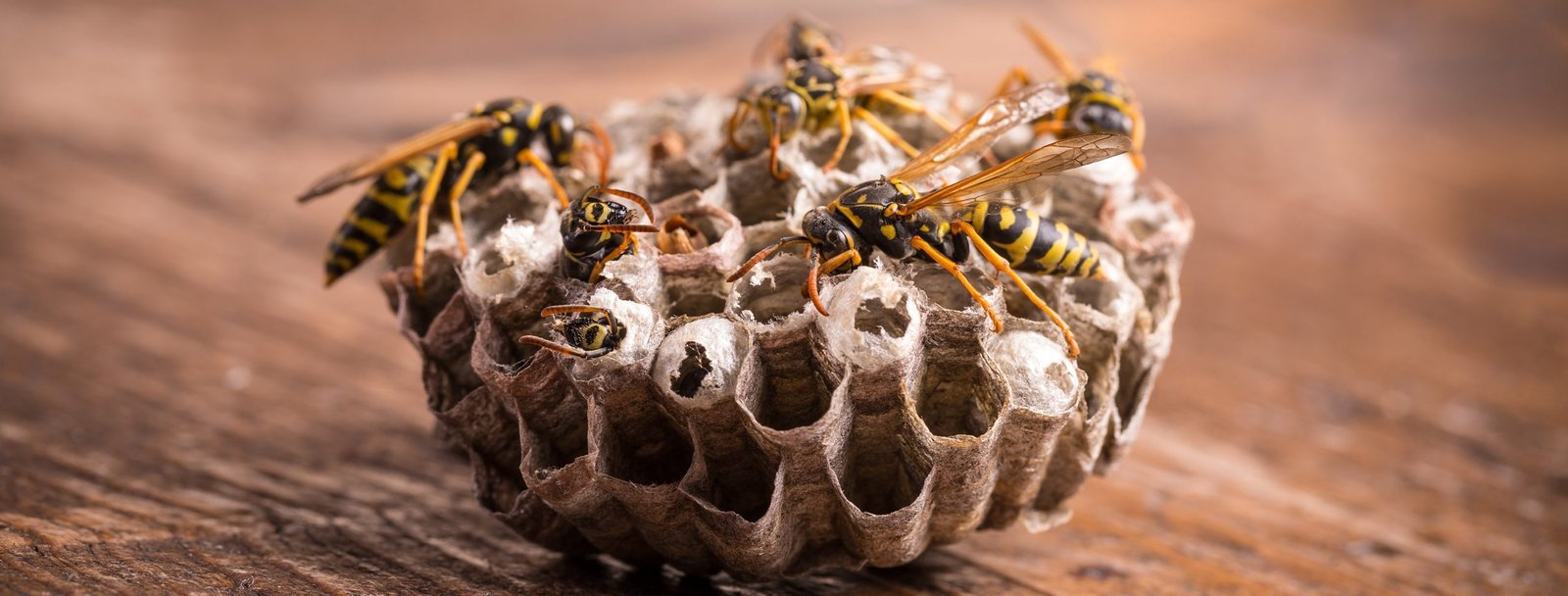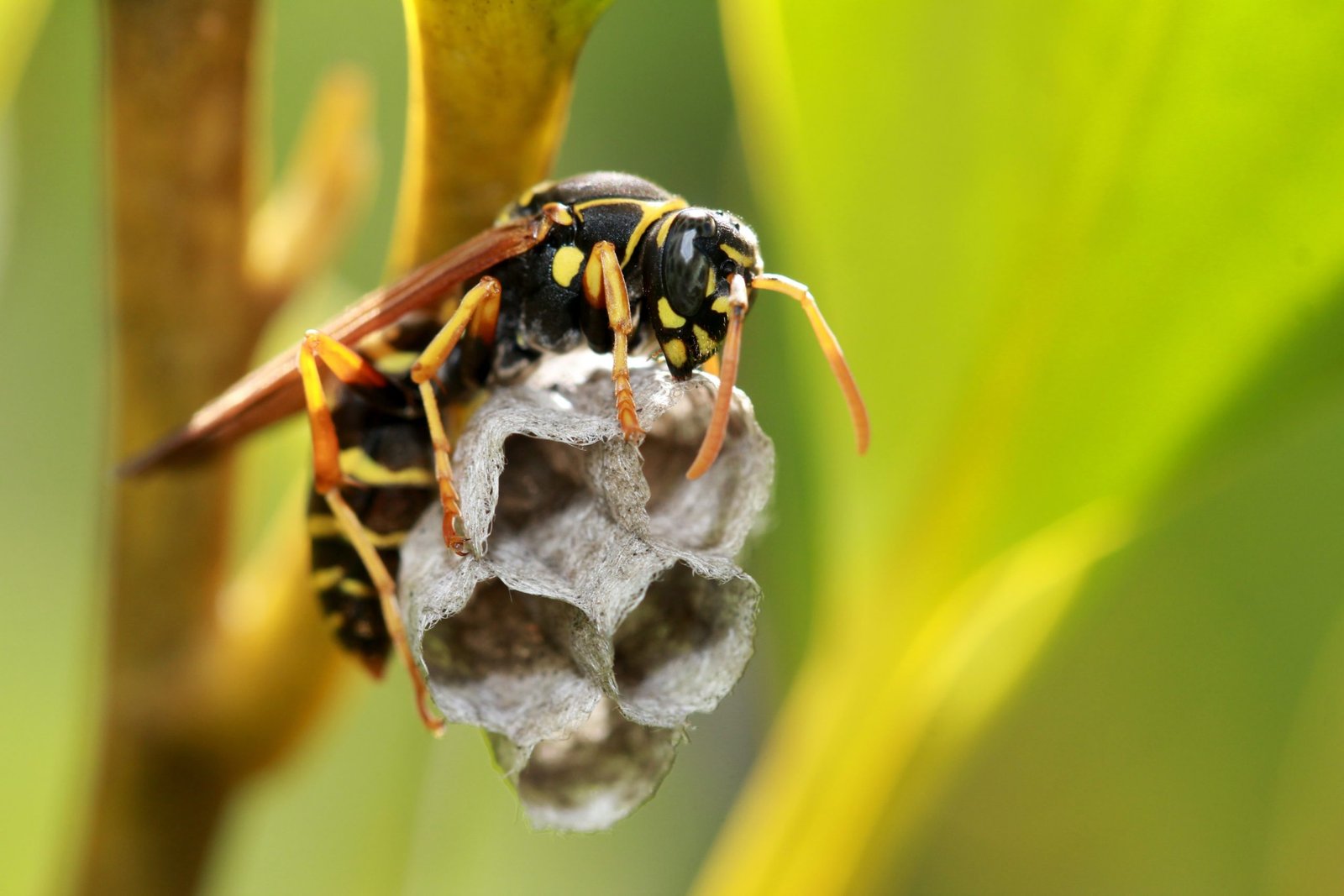Paper Wasp: Polistes

Description Of The Paper Wasp
Paper wasps of the species Polistes are 1/2-inch to 3/4-inch long. With orange or yellow markings, they are brown wasps and long legs that hang down as they fly. They have a narrow, pinched waist and a spindle-shaped abdomen with a stinger, just like most wasps.
Paper wasp nests, resembling an inverted umbrella, are open. The nests face downward and are not enclosed in a paper envelope, unlike the nests of yellow jackets and hornets. 1Go To Source maine.gov -“Paper Wasp”
Learn More: Painful Insect Stings
Paper Wasp Behavior
Most paper wasps, except new queens, die during the winter. Queens survive the winter by nesting in secured areas, such as under the bark of trees or in cracks and crevices. Several queens commonly get together in the spring to start a new nest. Finally, the other ones will be dominated by one queen, making them serve as workers for the new colony.
This wasp makes paper-like nests in the shape of an umbrella by scraping and chewing wood into a pasty pulp. In protected areas, such as shrubs, tree branches, door frames, porch ceilings, windows, roof overhangs, attic rafters, and under decks, joists, or railings, these nests are constructed.
On the underside of the nest, the queen deposits eggs in the comb (cells). The grub-like immatures are mostly fed by other insects, such as caterpillars, that the worker wasps collect after the eggs hatch. They pupate in their cells once the larvae have matured, and join the colony as an adult. Adult paper wasps feed predominantly on nectar.
Though paper wasps do not frequently attack people, they will sting if they feel threatened or provoked. When people bumble into paper wasp nests hidden in bushes or around homes, they are stung several times. 2Go To Source clemson.edu -“Paper Wasps”
Life Cycle Of Paper Wasps

Paper wasps are semi-social insects, and three castes are found in colonies: workers, queens, and males. Fertile queens rule colonies located in protected habitats often found in crevices and under tree bark. The queen wasp selects a nesting site in the spring and begins to construct a nest.
In cells, eggs are laid singly and hatch into legless grub-like larvae that develop before pupating through several stages (instars). Until developing larvae pupate, cells remain open. Sterile worker wasp contributes by building the nest, feeding the young, and defending the nest.
A typical paper wasp nest contains 20 to 30 mature adults. Queens stop laying eggs in late summer, and the colony soon starts to decline. In the fall, the queen’s matted female offspring search for sites to survive the winter. The queen is often the only member of the colony to survive the winter. 3Go To Source texasinsects.tamu.edu -“Paper Wasp”
Paper Wasp Defense Mechanisms
Paper wasps (Polistes spp.) face opponents with raised wings, waving front legs, abdominals curved toward the predator, and wings flipped, fluttered, or buzzed. Such threats inform the predator that it is spotted, and if the advance continues, an attack/sting will ensue. 4Go To Source sciencedirect.com -“Paper Wasp”
Habitat Of Paper Wasps
The nests are made of paper composed of wood fibers scraped from weathered boards or branches and mixed with adult women’s saliva. Each spring, nests start from scratch; they are very rarely reused.
Nests are made up of single-layer open cells facing downwards and are often placed in open buildings or other sheltered sites under eaves. The nests do not have any outer covering. 5Go To Source nature.mdc.mo.gov -“PAPER WASPS Polistes spp.”
Paper Wasp Range & Distribution
The United States is home to at least 16 indigenous species and one invasive paper wasp species (Polistes dominula). Some species’ ranges extend to Southern Canada or Northern Mexico. The exact distributions of the various species are, however, currently unknown.
Diet Of The Paper Wasp

In particular, adult paper wasps feed on nectar or other sugar solutions, such as honeydew and ripe fruit juices. Adults also feed on bits of caterpillars or flies that are caught and, before presenting to their young, they are partially chewed.
Adult paper wasps are efficient predators. They transport caterpillars back to the nest and feed them to the larvae that are developing. During a season, they will collect great numbers of caterpillars from the area around the nest.
Typically, adult wasps prey on a broad range of caterpillars, including corn earworms, armyworms, loopers, and hornworms. Adult wasps also use beetle larvae and flies as food for their young. 6Go To Source aggie-horticulture.tamu.edu -“Quick Facts”
Paper Wasp Predators
- Starlings
- Dragonflies
- Magpies
- Praying Mantis
- Robber flies
- Moths
- Beetles
- Hoverflies
Paper Wasp Interactions With Humans
Wasps sting their victims from the rear of the abdomen and inject venom. The stinger is an altered egg-laying organ (ovipositor) in all wasps and bees, so only females can sting.
In the United States, venom is responsible for 40 to 100 deaths per year from ant, bee, and wasp stings. There are over 30 compounds in social wasp and bee venom, including biogenic amines, protein toxins, and various enzymes. Allergic reactions to venom proteins and enzymes are the result of most deaths from insect stings.
Typically, wasp stings result in intense pain, with swelling and redness at the sting site. Particularly severe are stings around the head, eyes, and neck. While pain is usually localized at the sting site, it is also possible to have large local and systemic (allergic) reactions.
When swelling and pain extend beyond two inches from the sting site, large local reactions occur. Typically, large local reactions are not life-threatening, but they can last for two to seven days. About 5 percent of individuals who experience a large local reaction will suffer an anaphylactic reaction (serious systemic hypersensitivity). 7Go To Source agrilifeextension.tamu.edu -“Paper Wasps, Yellowjackets and Solitary Wasps”
Sources:
- Powell, Peggy. “Paper Wasps.” Maine.Gov, West Virginia University Extension Service, www.maine.gov/DACF/php/gotpests/bugs/factsheets/paper-wasp-wv.pdf. Accessed 10 Feb. 2021.
- Benson, Eric, and Patricia Zungoli. “Paper Wasps | College of Agriculture, Forestry and Life Sciences | Clemson University, South Carolina.” Clemson Cooperative Extension College Of Agriculture, Forestry, And Life Sciences, Clemson University, www.clemson.edu/extension/beekeepers/fact-sheets-publications/paper-wasps.html. Accessed 10 Feb. 2021.
- “Paper Wasp.” Texas A&M AgriLife Extension, Texas A&M University, texasinsects.tamu.edu/paper-wasp. Accessed 10 Feb. 2021.
- “Paper Wasp – an Overview | ScienceDirect Topics.” Science Direct, Elsevier B.V., www.sciencedirect.com/topics/agricultural-and-biological-sciences/paper-wasp. Accessed 10 Feb. 2021.
- “Paper Wasps.” MDC Discover Nature, State Of Missouri, nature.mdc.mo.gov/discover-nature/field-guide/paper-wasps. Accessed 10 Feb. 2021.
- Bellmore, Laura. “Beneficial Insects in the Garden: #01 Paper Wasps.” Aggie Horticulture, Texas A&M University, aggie-horticulture.tamu.edu/galveston/beneficials/beneficial-01_paper_wasp.htm#:%7E:text=for%20their%20young..-,Adult%20paper%20wasps%20primarily%20feed%20on%20nectar%20or%20other%20sugary,before%20presenting%20to%20their%20young. Accessed 10 Feb. 2021.
- Texas A&M AgriLife Extension Service. “Paper Wasps, Yellowjackets and Solitary Wasps – Do Solitary Wasps Sting?” Texas A&M AgriLife Extension Service, 4 Mar. 2019, agrilifeextension.tamu.edu/library/insects/paper-wasps-yellowjackets-and-solitary-wasps/#:%7E:text=Although%20thousands%20of%20North%20American,important%20stinging%20pests%20in%20Texas.
